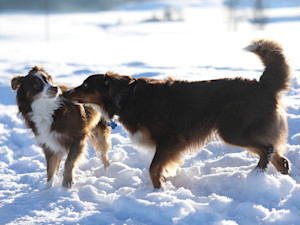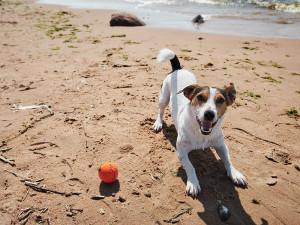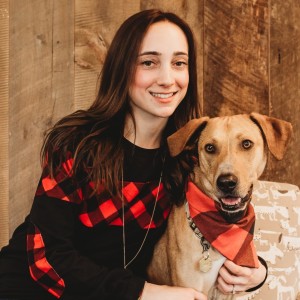Can Dogs Communicate With Each Other?
It’s about more than barking.
In This Article:
How Do Dogs Communicate with Each Other? Specific Dog Communication Methods Breed-Specific Communication Traits The Importance of Context Frequently Asked Questions
Dogs are highly social animals with a complex system of communication that allows them to interact with other dogs and humans. Through a combination of body language, vocalizations, scent signals, and expressions, dogs can convey various emotions, intentions, and information to one another.
Even though your dogs are speaking another language, if you carefully observe them, you will be able to understand their “language” and bring your relationship to the next level. Understanding how dogs communicate is an important skill for dog parents. It can prevent a dog bite, or dog fight, and help a scared or nervous dog feel comfortable. When reading your dog’s body language, it’s important to look at the whole picture of your dog to get the full message they are trying to relay.
Dogs use the forms of communication below to allow humans and other dogs to understand what they are feeling. Understanding your dog’s body language can help you keep yourself, your family, and other dogs safe in all situations.
How much do you spend on your pet per year?
How do dogs communicate with each other?
Dogs communicate with each other through body language and sounds. When a dog is a puppy they learn how to communicate through interactions with their mother and siblings.
Can dogs communicate with each other by barking?
Yes, dogs use barking as a form of communication. Typically, a dog barking at another dog can communicate excitement, a need for space, or an alert that it is frustrated. The different tones in a dog’s bark can help you differentiate what the bark is trying to tell the other dog. A bark during play sounds more exciting; it is usually higher pitched. A bark when a dog tries to get space or show frustration will be much deeper.
Other vocalizations
Growling, whining, and howling can be other vocalizations that dogs may use to communicate with other dogs. Each type of vocalization communicates a different message. When a dog growls, it is typically a warning sign that they are trying to give off, there is something they are not fond of and would like it to stop. When a dog growls and the other dog listens they prevent the escalation of a situation. Growling can also be playful. Some dogs are very chatty when they play, and growling is part of the way they play. It can seem scary from the outside, which is why it is important to know your dog.
A dog whines when they are trying to communicate a need, they may need food, water, or to go outside to pee or poop. Some dog breeds can howl. Howling can be used for excitement, but it also may be used to alert. Have you ever noticed your dog sneezing when they are excited or want to play? Dogs sneeze to communicate excitement or happy feelings, or maybe they just got a tickle in their nose. Snorting is another form of communication that dogs use. Dogs may snort to communicate that they want attention or are frustrated.
An air snap is a big form of communication coming from your dog. If you notice your dog air-snapping at another dog, they are trying to tell them they are very uncomfortable. If does an air-snap and the other dog does not stop their behavior, they may feel motivated to bite. Typically, if a dog is air-snapping, they have tried many other forms of communication and their message was not received, so they are now going to the next level.
Smell
Dog scent plays an integral role in communication, dogs can learn a lot of information about other dogs from their scent. Dogs use their urine or scent glands in their paws to leave messages wherever they go. Their scent can communicate their gender, age, whether they are spayed/neutered, and their health or emotional status.
Sight and sound
Dogs observe their environment and use their sense of sight and sound to understand what is happening around them. Because dogs cannot communicate with words they use their senses to get their message across and to understand them.
Specific dog communication methods
Do dogs communicate with their tails?
A wagging tail does not always mean a happy dog. Tail movement is one of the ways dogs use their body to communicate. The height and speed of a dog’s tail have a lot to tell about how they are feeling. A tail pointing up high means that your dog is alert and excited, this could be to see their friend or squirrel that ran across the street and they want to chase it. When their tail is wagging straight out from their body in line with their back that means they are feeling neutral about a situation or may be exploring intently. If a dog’s tail is pointing down it may be a cause for worry, this position typically means they are submissive and concerned.
When the tail is wagging, it adds more meaning to the position and body language your dog is trying to convey. A fast wagging tail is an excited dog, and wide strokes mean that your dog is happy. When you see a dog’s tail wagging slowly, they are not thrilled with the situation, and when the tail is moving low and very slow they are stressed or anxious.
Facial expressions and eye contact
Has you ever seen a dog smile? A smile in dog language can mean different things, and it is not always the same as a human's smile. A dog that is showing relaxed body language, and a happy tail wag may smile if they are enjoying something. But a dog may also smile when feeling frightened (look for other signs of fear in dogs). They will also lift or curl their lip if they want to show that they need space from a situation.
Additionally, ears are a body part used in dog communication dogs ears are always moving and giving off more information than you would think. Whether your dog has pointy ears or floppy ears they will still give off messages. If you have ever noticed your dog’s ears go flat or pulled far back on their head your dog is trying to show that they are scared. Ears up may mean they are alert and curious listening to what's happening around them.
Not only can dogs communicate by body movements they can also use their eyes to communicate. Staring is a rude behavior in dog language, it can lead to intimidation and the build-up can cause a dog fight. Slow blinking and soft eyes during eye contact mean they are calm, content or happy. Or they may show the whites of their eyes, aka “whale eye.” Whale eye communicates that your dog may be worried or stressed. If you notice whale eye along with other signs your dog is uncomfortable, it is best to get them the space they need.
Scent-marking
Marking is a way for a dog to tell other dogs or animals they have been here. Dogs may mark to tell other dogs they are frustrated or anxious. A dog who has been spayed or neutered may be less likely to mark to show territory.
Breed-specific communication traits
Howling would be considered a breed specific communication trait, but not all dogs can howl. Certain breeds also have different types of barks that they use for communication, though other dogs may not have the ability to make similar sounds. Wolf related breeds such as Shar-pei, Chow-Chow or Basenji are unlikely to bark, but hunting breeds will use a specific type of barking to get their message across.
The importance of context
Observing your dog as a whole is important to understand what they are communicating. Looking at one form of communication/body language may not always tell you exactly what your dog is trying to say. But if you look at the dog as a whole; the environment and each part of your dog (vocalizations, body posture, tail, eye contact, and facial expressions) you will get a clear picture of what your dog wants to tell other dogs.
FAQs (People also ask):
Are my dogs arguing with each other?
Dogs can argue or disagree with each other. When dogs are not very social or do not listen to another dogs’ body language, this can cause issues. Social dogs will have a disagreement and communicate with body language and then resolve the situation by giving each other space. Dogs who are not well socialized or don’t understand how to read other dogs’ cues may cause an argument to become worse by not taking a hint and a dog fight may happen.
Do dog growls mean aggression?
No, a dog’s growl does not always mean aggression. A growl is just a way for a dog to give information that they are displeased or need space. Typically, a growl is used to prevent a situation from escalating. If the other dog does not pay attention to the growl, or accompanying body language, a fight can start.
What does a stiff dog mean?
If you notice a dog with stiff body language, this dog is uncomfortable. A stiff dog may look frozen or tight when moving.
What does a loose dog mean?
Loose dog body language shows the dog is relaxed and ready to play. A loose dog is happy, calm, and enjoying the environment.
What does it mean if your dog’s hackles are up?
When a dog’s hackles go up, that means the hair along their spine is standing straight up. When this happens, it can mean a few different things. Your dog may be defensive, excited, afraid, uncertain, or surprised.







